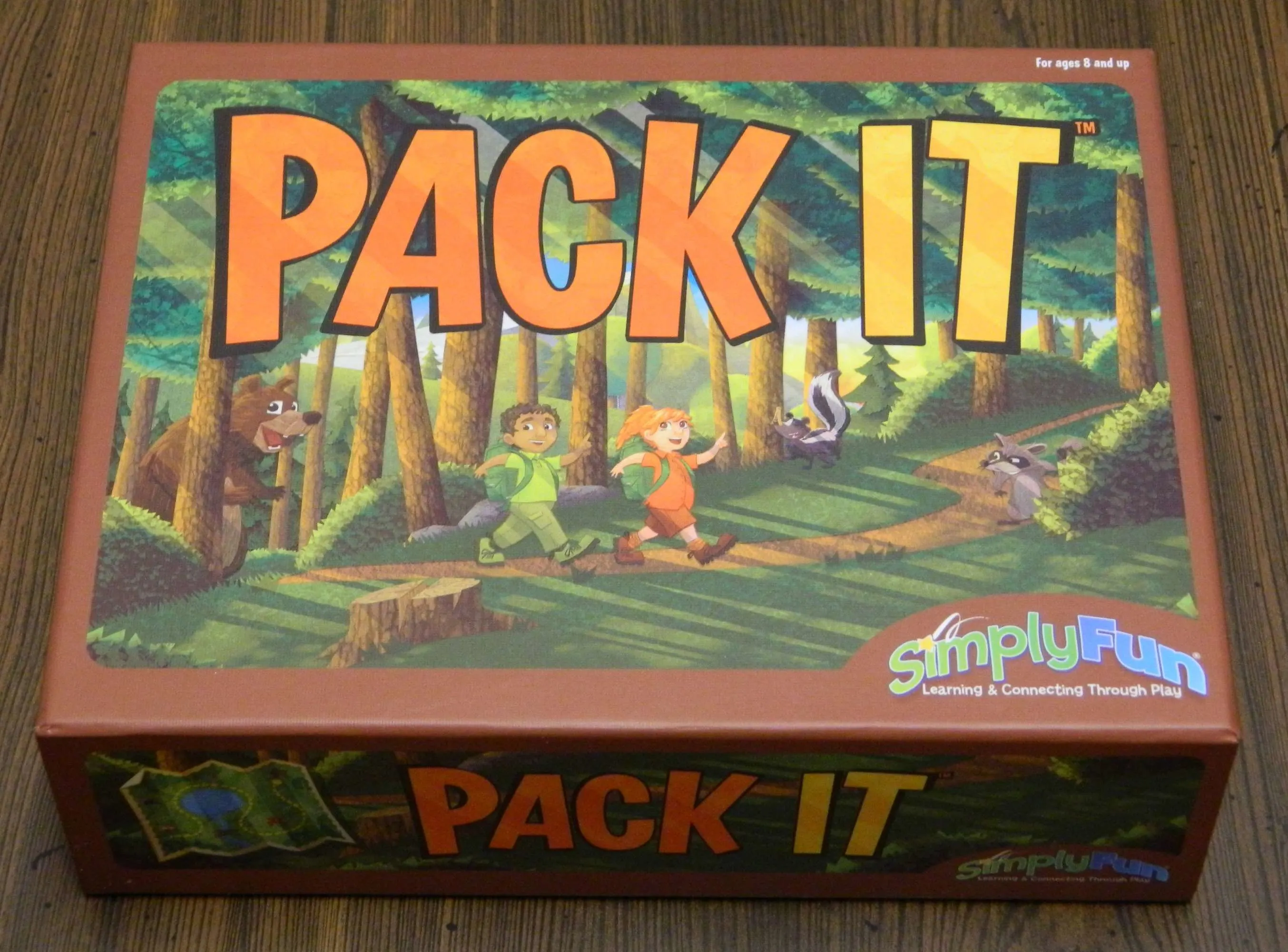How to Play
Pack It is a 2014 risk and reward/press your luck card game from SimplyFun with a hiking and camping theme. The game was previously released as Let’s Take a Hike at StrataMax Games until SimplyFun licensed it from them. Like all of the games SimplyFun makes, Pack It is very simple to learn and incredibly easy to play.
Setup:
As with most games, Pack It begins with a few quick game setup steps. First, put the lead hiker card in the middle of the play area (so all players can reach it) and give all players a different pawn and the scoring card that matches its color. Shuffle all of the rest of the cards (all green and blue item cards and red hazard cards) and deal five cards to each player. After you are done dealing, place the rest of the card deck face down in the middle of the table (leave room for both a discard pile and a hiking pile).
All players look at the cards they were dealt and begin to “pack” their own hiking backpack by placing all five of their cards in a valid spot (based on the red icons in the upper left corner of the card). A complete backpack has five cards laid next to each other with one additional card placed on top of the middle card and one below it (a total of seven cards). See the image in the playing the game section below for an example of a complete backpack. Cards can only be placed in the backpack locations indicated by the red icons. For example, the sleeping bag can only be placed at the bottom of the backpack (the one below the middle card) and the bear spray has to be played one card to the right or left of the middle. If a player is dealt one or more red hazard cards (this rule only applies during setup), they discard them to the discard pile and draw back up to five cards. However, if a player is dealt a card that they can’t fit into their backpack (for example they get two sleeping bags which can only be placed in one specific slot so two can’t fit in a backpack) they must discard it and do not get a chance to replace it with a new card. Once everyone has set up their backpacks, if there are any cards in the discard pile they are put back into the draw pile and re-shuffled (this is the only time this will happen in the game).
Playing the Game:
The player who most recently went camping starts the game and play continues in a clockwise manner until all cards have been drawn and the game ends. Each turn, a player has only two options to choose from, draw a card or take a hike. Most turns players will elect to take a card. In this case, they draw a card and either try to fit the item into their backpack or deal with a hazard card. If the card is a green or blue item card they place it in their backpack in a valid spot. If the spaces the item can be placed in are filled, the player re-arranges their backpack to make it fit. However, if the player cannot fit all of their items in their backpack, they must discard one of their item cards (it doesn’t have to be the one that was just drawn, you can discard another card to make room for the new item). If forced to discard, the player does not get to draw again this turn.
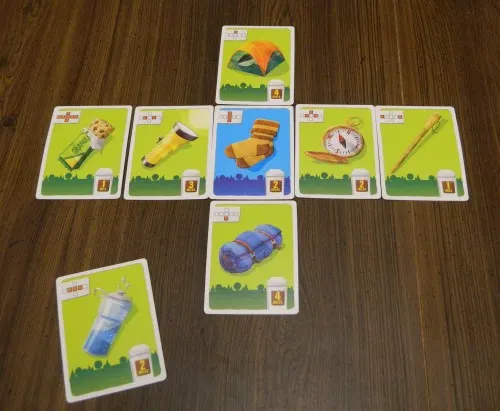
This is an example of a fully stocked backpack, all seven spaces are full. This player probably wouldn’t be drawing any more cards (they would likely elect to go on a hike) but if they did decide to try to improve their backpack and drew a water bottle, they could elect to get rid of the middle socks card, the flashlight, or the compass to make room for it. They could also technically get rid of the tent or sleeping bag, move the socks card to the previously occupied space, and put the water bottle in the middle. Otherwise, they could always just discard the water bottle if they don’t want it.
Occasionally, while drawing a card a player will wind up drawing a red hazard card. These cards are resolved immediately and the player who drew it does not draw again this turn. The following are the possible hazard cards you might draw and what they do:
- Raccoon card-Drawing a raccoon card forces the player to discard a card of their choice from their backpack (most likely something you have two of or a lower value item), unless the player doesn’t have any cards in their backpack.
- Skunk card-The player who drew the skunk card must discard any two cards of their choice from their backpack. If they only have one card in their backpack, they discard just the one and if they have no cards in their backpack, they ignore the effect.
- Blister card-Blister cards can be avoided completely if you have a socks item card in your backpack. If you do have socks, the blister card has no effect and you keep the socks card in your backpack. If you do not have a socks card, you must discard the card in your backpack with the highest number of miles (shown in the lower right corner) aka your most valuable card. Again, if you don’t have any cards in your backpack you ignore the effect.
- Bear card-The bear hazard card is the only one that affects all players. Whenever any player draws a bear card, the bear eats ALL of the granola bars in ALL backpacks unless they have a bear spray item card in their backpack (if so, they get to keep all of their granola bars and the bear spray item card). If a player has no granola bars in their backpack, the bear card doesn’t affect them.
When the red hazard card is resolved, it is discarded from the game and play continues normally.
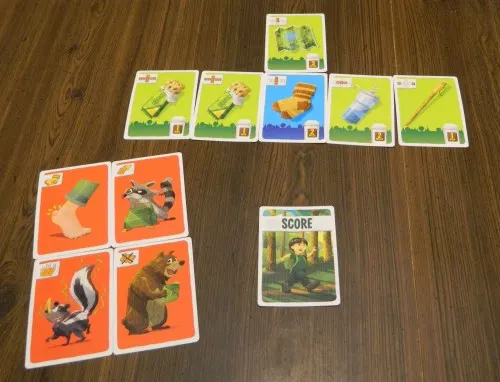
These are the four possible hazard cards a player could run into. In this case, the blister card would do nothing (since this player has socks in their backpack), the raccoon would force them to discard one card (they will probably choose to discard the extra granola bar), the skunk would make them discard two cards, and the bear would eat both of their granola bars (as well as all of the other granola bars other players have if they don’t have bear spray).
Taking a Hike:
The other option a player has during their turn is to start a hike. You are not required to have a full backpack to start a hike nor do you need any specific cards to do so. However, just like in real-life hiking and camping it is advised to be as prepared as possible with as many different items as you can get. Once you have a fully stocked backpack (all seven spots are full), there is pretty much no reason not to start a hike (unless you have like five granola bars and want to replace them with better items). Hiking is the only way to score points in the game.
If a player elects to start a hike, they do not get to draw a card this turn. The player announcing the hike places their pawn on the lead hiker card. Going clockwise all other players are asked if they wish to join the hike. They are under no obligation to do so but cannot score any points during this hike if they refuse to join. If they do join, they place their pawn behind the lead hiker pawn. Players not taking part in the hike do not get to take their turns until the hike is completed (they just sit there waiting until the hike is completed).
Once all players have indicated whether they are joining the hike or staying home, the lead hiker (the player who started the hike) draws a card from the draw pile and places it face up on top of the hiking pile. If the card is a blue or green item card, players see if they have the same item in their backpack (for example, if the card drawn is a granola bar they look to see if they have a granola bar in their backpack). If so, they don’t have to do anything and they keep the card in their backpack. If they don’t have the same card they must discard one or more cards that match or surpass the miles printed on the card that was drawn in order to stay on the hike. For example, if a tent (four miles) was drawn and the player doesn’t have one in their backpack they could discard a sleeping bag (worth four miles) or water and a compass (worth two miles each for a total of four miles).
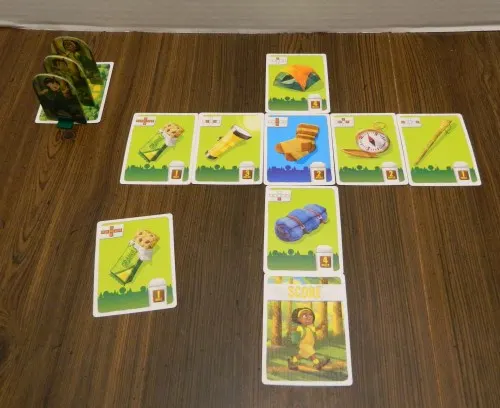
There will almost always be more than one player in a hike but I’m just showing one player for the sake of simplicity. The first card drawn is a granola bar. Since the yellow player has a granola bar, they are safe and do not have to discard anything (and they keep their granola bar as well).
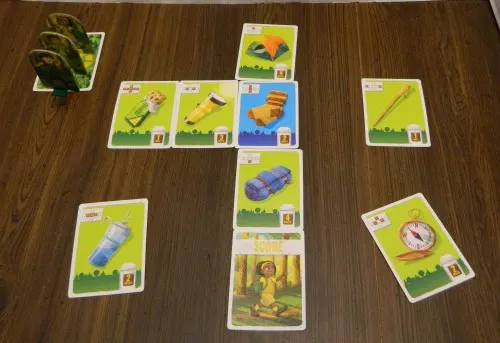
Unfortunately, this time the yellow player wasn’t so lucky. The second card drawn was a water bottle. Since they don’t have one, they will have to discard one or more cards of equal value. Yellow elects to discard their compass.
If a red hazard card is drawn during a hike, their effects are now applied to all hikers rather than just the lead hiker (any players who sat out or dropped out of the hike before the hazard was drawn are safe though). Other than that they are played the same way (raccoons make everyone discard a card of their choice, skunks force two cards to be discarded per player, sock cards still prevent blister cards from taking effect but otherwise force you to lose your most valuable card, and bear cards eat all granola bars unless you have a bear spray card).
Once the card drawn is resolved (either by matching or discarding), all hikers (in clockwise order starting with the lead hiker) decide if they wish to continue on the hike or drop out. If a hiker chooses to drop out of the hike, they take one card from the hiking pile (whichever one they want) and place it underneath their score card (these will count as points based on the miles printed on them when the game ends), not their backpack. Players who drop out keep all of the rest of their cards remaining in their backpack (but they stay in their backpack, they aren’t added to their score pile). If there are no cards in the hiking pile, any players who elect to drop out do not get to add any cards to their score.
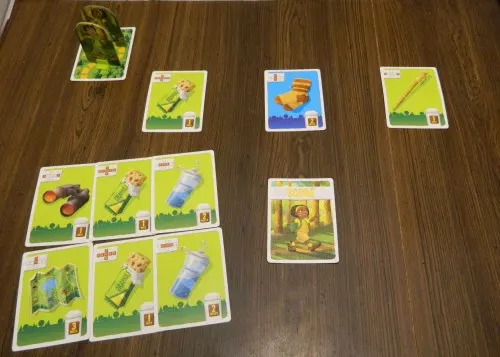
The yellow player keeps getting hit with cards they can’t match so with three items left in their backpack (all of which are low value) they decide to leave the hike before they get stuck with nothing. Of the six cards in the hiking pile, the map is the most valuable so they take it and put it under their score card. The other remaining players can decide to quit as well (and take any other card in the hiking pile) or try to tough it out for a bigger haul (the last player in the hike gets to take all of the remaining cards in the hiking pile as long as they get out before they lose everything in their backpack).
The hike continues until all players have dropped out of the hike, have run out of items in their backpacks, or can’t match the amount of miles on the card that was drawn with cards from their backpack (in both the second and third cases, the player must drop out of the hike and they don’t get to take a card from the hiking pile). The last hiker does not need to stop once all the other hikers have dropped out and can continue drawing as many new cards for the hiking pile as they wish. As long as the last player in the hike drops out before they run out of items in their backpack, they get to add all of the remaining cards in the hiking pile under their score card.
Once the hike has ended (all hikers have dropped out), play begins like normal again starting with the player to the left of the original lead hiker. They can either draw a card for their backpack or start a new hike.
Game End and Scoring:
Pack It ends immediately after all of the cards have been drawn from the draw pile unless a hike is still going on (in this case, re-shuffle the discard pile to make a new draw deck to complete the hike). Once the game has ended, each player counts the miles shown on the cards in their scoring pile (cards in a player’s backpack do not count towards their score). The player whose scoring pile cards add up to the most miles is the winner. If there is a tie, the player that has the most cards in their scoring pile is the winner. If the tie still hasn’t been broken after that, re-shuffle the discard pile and have the tied players draw cards until someone draws the skunk (they not surprisingly lose the tiebreaker).
Backpack Rules:
Players lay out the items they get in a cross-like formation to form their backpacks. As stated earlier, there are only seven spaces in a player’s backpack and most items can only fit into a couple parts of the backpack (indicated by the red icons in the top left of the card). There are no limits on how many of an item you can have (as long as they all fit into different slots of your backpack you are fine) and no reason to discard anything that can fit into your backpack but you probably won’t get too far in your hike if you don’t have a wide variety of items. Items in your backpack can be re-arranged at anytime to make room for a new item, the only time you will have to discard anything while packing your backpack is when the new item can’t fit into any sections of your backpack (in which case you will have to either discard the new card or make room for it by discarding something else). The only real rule restriction is that you can have only one item card per backpack space (you obviously can’t just stack the cards on top of each other in the same slot).
Review
Pack It isn’t an amazing or revolutionary game by any means, but it is a very solid family friendly card game that players of almost any age should be able to understand. SimplyFun’s target audience is families (especially ones with young children or tweens) and Pack It definitely fits into that niche very well. While hardcore gamers might scoff at how light the game is and how much it relies on luck, it is a very good fit for families (especially ones who love to hike, camp, and explore the outdoors). However, I personally consider myself a hardcore gamer (though one who likes to play light games from time to time as well) and I did enjoy Pack It quite a bit.
The Negatives:
I’m going to get the negatives out of the way right off the bat. First of all, if you hate press your luck type games (or games that have a lot of luck built in) Pack It definitely isn’t for you because the game is almost completely reliant on luck. If you keep getting hit by hazard cards, getting the same items for your backpack over and over again, or seem to never have the cards that are revealed during the hike you are in serious trouble. Press your luck games do require a little bit of strategy (making sure you get out before disaster hits, trying to figure out when your opponents are going to abandon the hike, etc.) but the main component of Pack It is luck.
Second of all, Pack It isn’t particularly original and doesn’t really add anything new to the genre. There are so many press your luck games and other similar card games out there. In fact, the critically acclaimed Incan Gold, which I reviewed about a year ago is very similar to it. There are some minor differences and Pack It adds some protections (as well as other various mechanics) but the two games are quite similar. However, while Incan Gold has a bit more strategy, it is also less simplistic and harder to play than Pack It. Basically, I would say that Incan Gold is better for more strategic gamers while Pack It is better for people with families or who prefer their games to be easier and lighter to play.
The last (in this case very small and nit-picky) problem I have with the game is the lack of play mats. I personally had no problem whatsoever (the red icons are pretty self-explanatory) but I did have one player in my game that struggled to figure it out for some reason. Very young children or certain non-gamers might struggle with it but it shouldn’t be a big problem for most players. Also, it would just be nice to have the play mats for organization reasons (so you can more clearly see what you have and which spots you still can fill). Again, not a big deal but play mats would have been a nice addition.
Great Components and Theme:
On to the things I liked the most about Pack It, which are the components and the theme. First of all, the art in this game is extremely cute and kids should absolutely love it. I’m in my late twenties and even I love the art style in Pack It. When I was researching this game’s predecessor (Let’s Take a Hike) I saw the art they used and while it was solid, it was nowhere near as cute or loveable as it is in this version of the game. I greatly prefer the art style in Pack It.
The components are also pretty great, as they usually are in SimplyFun games. The card stock is pretty good and while the tokens are just cardboard cutouts on stands, the art is great on them. The theme (camping and hiking) works very well and makes complete sense. I’m not an avid hiker (I have done some light hiking and hope to do more in the future) but I love the theme. In most games, game mechanics are created and a suitable theme is chosen afterwards (which may or may not make sense). In this case, everything in the game makes logical sense (packing your backpack well is an essential part of hiking, you need to plan ahead with enough supplies, and if you go on a long enough hike some of your gear might get lost or damaged) and nothing is shoehorned in poorly. Also, hiking and camping isn’t a common theme in gaming so Pack It fills a niche.
Learning:
One of the things SimplyFun puts an emphasis on in their games is learning. Most of their games are light strategy games that you can play with your family and teach your kids a few things while playing. Unfortunately, Pack It is a little light on the teaching element. It does teach risk and reward and planning/preparation but you can get that from pretty much every game out there. Adding some flavor text to teach kids about responsible camping and hiking and helping the environment might have been a good addition to the educational value of the game.
Not a Ton of Strategy But Some Interesting Decisions:
I really wish there was a little bit more strategy in Pack It but the game does offer some interesting decisions. For example, sometimes you have to stay on the hike longer than you would like just to make sure another player doesn’t run away with the game (if they are un-opposed and have a well-stocked backpack they could last a long time and gather a ton of points in just one hike). In both of the games I played, a player got a great backpack (covering them for pretty much every card that could possibly come up during a hike) and was extremely lucky with having the cards needed to match (so they would rarely lose anything out of their backpack). We had to stay in hikes longer than we would have liked to just to keep the game somewhat close.
You also have some interesting decisions to make when it comes to discarding cards during hikes. Do you ditch a less valuable (in terms of miles) granola bar knowing that it is more likely to come up or get rid of something more valuable to keep the granola bar in your backpack? Is it better to get rid of two cards (say a two mile and a one mile card) or sacrifice an extra mile and get rid of a tent (since getting rid of two cards means getting rid of two possible matches while the tent only covers one thing)?
Apparently in Let’s Take a Hike (the original version of this game), you actually played hazard cards against your opponents instead of being hit by them yourself. I’m not sure which method I prefer. I usually hate games that rely heavily on harming other players (I’m a pacifist who would rather build up my own score than tear down another player) but this would add some more strategy to the game. However, the original game apparently had way too many hazard cards so games could easily turn into bloodbaths. The hazard cards were also different, including skunks that turn up during hikes ending the hike for all players with anyone remaining not getting to bank any cards out of the hiking pile. Overall, I think in some cases Pack It improved the formula (it simplified the game and stuck more to the heart of the game, the press your luck mechanic, instead of adding ways to mess with your opponents) but there are also some elements I wish the game would have kept (especially the skunk ending the hike since it added even more press your luck mechanics to the game). The good news is that if you prefer the Let’s Take a Hike rules, there’s nothing really standing in your way to do so (you have all the cards you need to play by either sets of rules). Just change what the cards do to match Let’s Take a Hike.
Bang for Your Buck:
Pack It retails for $24.50 on SimplyFun’s website (you can also purchase it from your local SimplyFun representative/consultant). I think that’s a decent price for the game. That’s about the going rate for a card game these days and Pack It is a solid one with some pretty nice components. It isn’t an amazing bargain but it definitely isn’t overpriced. The game comes with a decent amount of cards (102) but I kind of wish a few more were included (or the rules were changed to allow for a re-shuffle or two) to extend the game a bit. Games go by very quickly (the box says 20-30 minutes, I would say twenty minutes tops once you know what you are doing) and while you can always just play it again, I would prefer this game to be more in the 30-40 minute range (especially since you will probably only get to go on four or five hikes per game if you play by the normal rules).
Final Verdict
Pack It is a solid but unspectacular press your luck card game which has both pros (great theme and components, easy to learn and play, and some interesting decisions) and cons (almost completely luck-based and not particularly original). Kids will likely enjoy the game more than adults but this is a game that parents probably won’t dread having their kids ask them to play with them. For more hardcore gamers who prefer strategy over luck, I would recommend Incan Gold instead (though Pack It is a decent second option if you find it for a good price). I am giving Pack It a three out of five and recommend it for families looking for a simple press your luck game to play with their kids. For strategy gamers, even though I personally enjoyed the game (and consider myself a hardcore gamer as well as a casual one) I don’t think I would recommend Pack It unless you find it for a cheap price. Recommended for families, wait for a deal for hardcore gamers.

